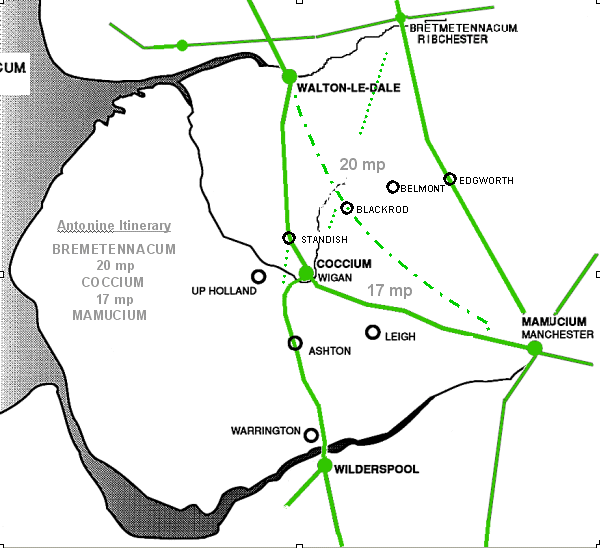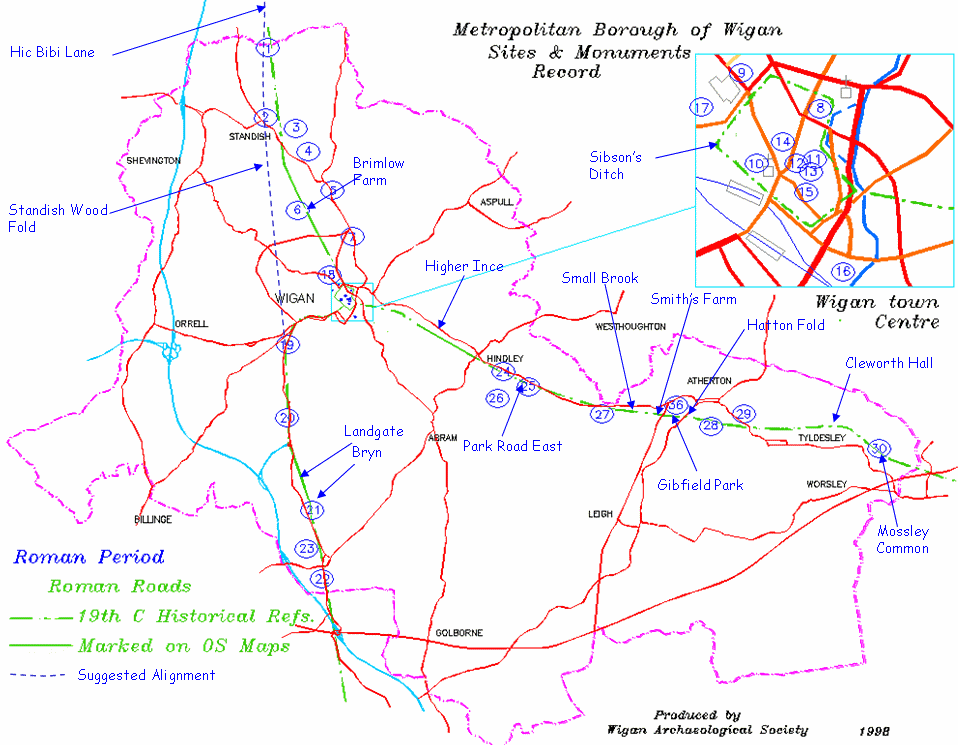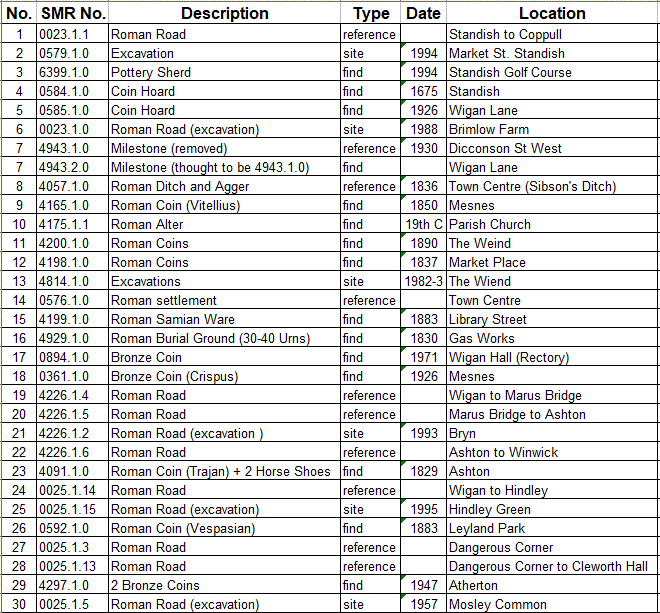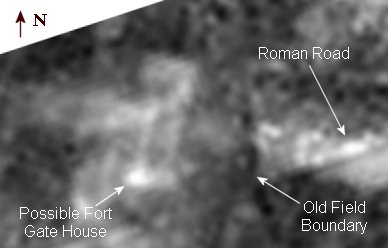The Wigan Archaeological Society has been investigating the Roman roads in the Wigan area for many years and, despite the urbanisation and industrialisation we’ve suffered over the years, have had some notable success in tracing them. These pages record in detail our work and what our researches have discovered.
Over perhaps the last century and a half it has been generally been accepted that there were three Roman roads leading into Wigan. These were originally identified and traced by the 19th century antiquarian Rev. Edmund Sibson and then later endorsed by W. Thompson Watkin. Both Sibson and Watkin were keen supporters of the idea that Wigan was the Roman station of Coccium which appears in an early 3rd century AD document called the Antonine Itinerary.
The name Coccium appears in the Itinerary’s 10th Iter lying between Bremetennacum (20mp) and Mamucium (17mp). Bremetennacum has been confirmed as Ribchester by the discovery there of an engraved stone (RIB 583) in the 16th century (rediscovered in 1814) – and, for etymological reasons, Manchester has always been assumed to be Mamucium.
Location of Coccium
Wigan, as can be seen on this map, is not on the direct route between these two places, so not surprisingly, over the years other candidates for Coccium have been claimed (and sometimes still are). Even as early as the late 17th century Cockey Moor, a spot east of Ainsworth near Bury, was suggested being marked on Robert Morden’s map of Lancashire. This is on the well established Roman road on the direct route connecting Manchester with Ribchester.
Edgeworth was favoured by Rivet and Smith (Place Names of Roman Britain -1979) as it also lies on this route. However, despite extensive searches over years, both here and further south at Affetside, a substantial settlement or fort along this route has never been found.
Wayoh Bridge. A possible fort was identified here in the early 1980’s by aerial photography just north of Edgeworth and reported as a possible candidate (Pastscape No. 44354). More evidence of fort-like earthworks was revealed recently by LiDAR (Ratledge – Roman Roads in Lancashire) but its size suggests it’s just a fortlet or staging post.
Blackrod was preferred by the 18th century antiquarian J. Whitaker who claimed the A6 as the Roman Road out of Manchester (History of Manchester 1771 Chapter IV P.157). His projected route, however, was leading to Lancaster not Ribchester. He also insisted that the fort lay on the banks of the River Douglas north east of Blackrod. Despite this however, the 24″ OS map of 1893 has Coccium marked in the town centre (excavations at Castle Croft in the 1950’s found no evidence of Roman activity there).
Belmont has also been suggested more recently but Belmont Road is an unlikely candidate for a Roman road.
Standish was identified by E. Wadelove reporting in Britannia 2001 Vol.32. This was based on the two Roman coin hoards found in 18th and early 20th centuries (although the later was found on the Wigan border). Nothing much else has ever been found in Standish from the Roman period. However Wadelove points to the fact that the projected line of the Roman road leading north from Warrington to Preston would pass Wigan some distance to the east. A route this way was preferred by Coddrington writing in 1903 and his suggestion of Standish Wood Lane as the Roman road is a popular choice. We investigated this route in 2010 with resistivity surveys either side of Lower Standish Wood Fold but failed to detect anything suggesting the continuation of the road in this area.
Wigan. Chance finds over last 150 years have strongly suggested that Wigan had a Roman origin, but it wasn’t until the early 1980’s that excavations in the Wiend in the town centre, provided for the first time, positive evidence for Roman occupation in Wigan town centre. This was followed in 2005, by the discovery of a large Roman Bathhouse in the Millgate area, proving emphatically that Wigan was a very significant settlement in the early 2nd century AD (you can see details of the excavations here).
Further excavations in 2008 between Millgate and Library Street identified a possible military barrack block which strongly suggested the existence of a Roman fort in the area. It is now generally accepted that Wigan was the Roman settlement of Coccium. However, of the roads the antiquarians detected in the 19th century, very little has been seen in recent years. Our Society (as well as professionals and others) have carried out many investigations on these routes leading into Wigan over the years. We have recorded these activities in reports and our Newsletters – the following is a list of all the investigations carried out by the Society over the years:-
1985 Brimlow Farm – Resistivity Survey
1988 Brimlow Farm – Excavation
1989 Brimlow Farm – Excavation
Newsletter34 – 2000 Brimlow Farm – Resistivity Survey
Newsletter54 – 2002 Brimlow Farm – Resistivity Survey
Newsletter57 – 2002 Small Brook – Resistivity Survey
Newsletter63 – 2003 Hatton Fold – Excavation
Newsletter65 – 2003 Walmsley Park – Excavation
2004 Brimlow Farm – Excavation
Newsletter83 – 2005 Ellesmere Park – Resistivity Survey
Newsletter85 – 2005 Ellesmere Park – Excavation
Newsletter102 – 2007 St William’s School – Resisitivity Survey
Newsletter107 – 2007 Leaway – Excavation
Newsletter110 – 2008 St William’s School – Excavation
Newsletter113 – 2008 Ince C of E Primary School – Excavation
Newsletter116 – 2008 Heber Street – Excavation
2010 Standish Wood Lane – Resistivity Survey
Newsletter149 – 2011 Cleworth Hall Farm – Resistivity Survey
Newsletter194 – 2016 Brimlow Farm – GPR Survey
Newsletter214 – 2018 Brimlow Farm – Excavation
2018 Brimlow Farm – Excavation Diary
You can see details of our recent investigations of the roads leading:-
north from Wigan to Walton-le-Dale here
south from Wigan to Warrington here
east from Wigan to Manchester here
Historical Environment Record (HER) – or Sites and Monuments Record (SMR).
In the late 1990’s the Society was involved in creating and maintaining the SMR. The map shown below shows the data for the Roman period (as known at the time) and includes the Roman roads as indicated on early OS maps and described by the 19th century antiquarians (the numbers refer to the entries in the SMR).

Possible 4th Road (Wigan to Ribchester)
The antiquarian’s case for Wigan was base on the distances quoted in the Itinerary, which are ‘reasonably’ correct (far closer than any other claimant). There is a problem, however, with the accepted route from Wigan to Ribchester, which is via Walton-le-Dale and Preston. It is actually 26 Roman miles and is also not in a direct line. A direct route in fact would be much more accurate – in fact almost spot-on. Could it be that, by the late 3rd century, a route this way had been established? Various alignments in the direction of Ribchester have been looked at over the years, in particular David Ratledge, formally of Lancashire County Council and also Jack Smith formally of Chorley Archaeological Society. In the early 1980’s, Chorley Society thought they had found the road on Healey Nab being possibly 4 yards wide (although they only excavated one side). They uncovering kerbing travelling for some distance in the direction of Heapy (this is where previously a hoard of Roman coins were found and a silver necklace which is now in the British Museum).
You can see details of our Society’s recent researches for the road leading:-
northeast from Wigan to Ribchester here.
Burscough
Exciting news of a new Roman site has emerged on the South West Lancashire plain. Steve Baldwin’s Bluestone Archaeology group have been investigating this site for many years revealing much evidence of Roman occupation over a long period . In 2018 however, our Society was invited to undergo a large area resistivity survey of the site and this, quite spectacularly, revealed the full extent of the site. Full reporting restrictions are still in place at the moment for security reasons but our survey results clearly show this to be a Roman auxiliary sized fort of about 4.3 acres. A later phase forlet is also clearly revealed positioned on the east gate (in a similar arrangement to the fort at Castleshaw). In our survey the east and south walls and ditches are well represented and the roads can quite easily be seen leading out from the centre of these. Intervallum roads are also visible and even buildings such as barrack blocks and a possible gatehouse on the east side (below is a small section of our survey showing the eastern gateway).
 Steve Baldwin’s excavations and geophysical surveys, in particular our resistivity scan, have enabled this site now to be fully Scheduled (1470328) which will hopefully protect it from any future development.
Steve Baldwin’s excavations and geophysical surveys, in particular our resistivity scan, have enabled this site now to be fully Scheduled (1470328) which will hopefully protect it from any future development.
In the meantime of course there are Roman roads to found linking the fort with other sites in the area. The one leading to Wigan is the one that particularly interests us and suggestions have already been made. Details of the investigations of the possible routes between Wigan and Burcough can be found here.

Used to have a map that was quite old showing the route of what was marked as”roman road” it followed atherton road in Hindley green and converged slowly into atherton road eventually joining it at holt street.
Just wondered if anyone has any further info on this would appreciate any help with my reseach.
Thanks
I also noticed that there are a couple of old bridges that cross borsdane brook.one is quite ornate and presumably has been protected from further delipdation by a metal frame. It crossed my mind that one of these bridges must have been roman in origin?
Hi George,
It would be fantastic if we could identify a bridge of Roman origin. However I suspect the these in Hindley are later as the Romans tended to use fords (unless the River was too large). When I get chance I’ll take at the ones you mention.
Bill
Hi George – the old map you mention is probably the 1849 6 inch OS map which shows the the line of the Roman road on later editions in Hindley and Hindley Green. And you are right that the line seems to cross Liverpool Road roughly where Holt Street is now. Here is a link to some of our research on this particular route http://wigan.romannw.com/ – (we have carried out more research since this was published particularly in the Higher Ince area which you can find if you search through our Newsletters – starting at No.99).
We have just started a group called Golborne Village Archives which is not just a discussion site for old memories of Golborne, but a historical research site. What are the chances of Golborne being a Roman Settlement back in the day? A “donkey bridge” was found under Tanners Lane which was originally thought to date back 1800 years but a borough surveyor commented that they wouldn’t rule out the possibility of it being a sandstone bridge over a stream built by the Romans?
Sorry that should read 800 years, thanks!
Hello!
I’m very interested to find out where all the Roman coins ect and baths were actually found.. I was born in Millgate 1963, by dad said they were found underneath where we were living @ the time? Obviously the building isn’t there now but think it was 46 Millgate need to double check..
Have you any photo to look at please,Iv got a couple from 1960s
Many Thanks
Jackie
Hi I live in hindley on the Waverley road estate,I was looking for any information on the old amberswood common infectious diseases hospital,is there any evidence it was there still in existence and could it have been located on or close to the old Roman road running across amberswood common roughly where the old tip was.